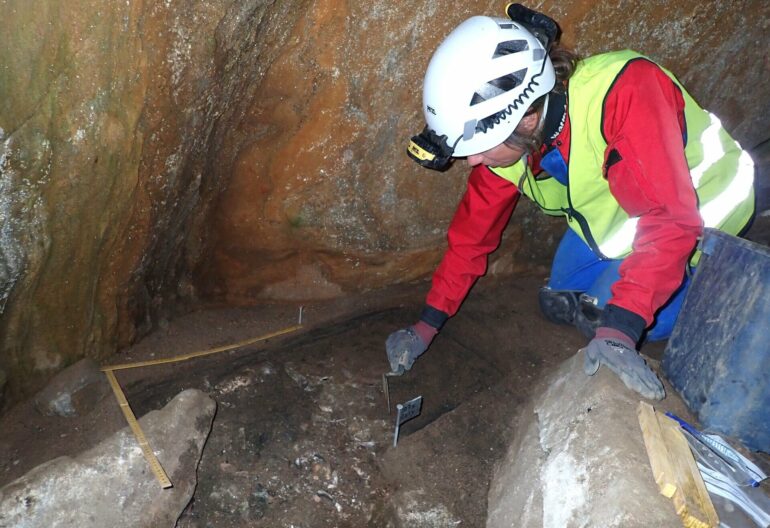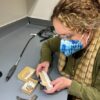By analyzing DNA and studying old animal bones, researchers have been able to reconstruct the animal diversity from a cave in Nordland, Norway.
“We have found several animal species that have surprised us. Among other things, we found the bones of animals that we see moving northwards again nowadays due to a warmer climate,” says Sanne Boessenkool, Professor at the Department of Biosciences, IBV.
She emphasizes that what happened to the climate after the last ice age cannot be used to take away the seriousness of what is happening as a result of current anthropogenic climate change.
“But this knowledge can help us to better analyze how climate change will affect animal diversity in the future,” says Boessenkool.
“We know that there was a warmer climate before, but we don’t know much about what kind of animals lived here at that time. Now we have new knowledge about how wildlife changed when it got warmer, after the end of the last ice age,” says Aurélie Boilard, Ph.D. candidate at IBV.
A unique cave
In a new article published in Science Advances, Boessenkool, Boilard and several other colleagues present results from excavations of a unique cave in Nordland in Narvik municipality. It is unusual to find such extensive deposits from this time period in caves. And it is even more unusual that so many bone remains have been preserved in the cave’s sediments.
“There are really few such sites where we have found bones and bone remains of animal communities that have been completely free of previous human impact or modern disturbance,” says Boessenkool.
The cave was discovered when part of the hillside was removed to build a road to the Norcem industrial site. The excavation was led by Trond Lødøen, Associate Professor at the University Museum of Bergen, and archaeologists, geologists and biologists participated in the study.
Collaboration between several universities, including the University of Bergen, NMBU,the Arctic University Museum of Norway and UiO, but also with industry—now Heidelberg Materials Sement Norway—has been important. “We have combined knowledge from osteology with DNA analyses of the bones. This has enabled us to reconstruct how animal diversity changed after the last ice age,” says Boessenkool, who is an expert in ancient DNA and changes in biodiversity.
She has collaborated widely with researchers from other disciplines to take a deep dive into the remains of what they could find in Nygrotta, which is part of the large cave system Storsteinshola in Kjøpsvik. Osteology is the study of bone tissue, bones and skeletons, and osteologists have helped to identify the species of the remains found in the cave
“But more than 90%, i.e., more than 2,000 bone fragments, could not be identified in this way. Many of the bones were too broken or damaged,” says Samuel James Walker, postdoctoral researcher at IBV and one of the osteologists involved in the project.
“The small bones and remains that we could not identify through osteology have been identified through a technique called DNA barcoding,” adds Boilard.
This is a technique where researchers can gain insight into and analyze DNA from the bone fragments to determine which family, genus or species it belongs. By combining osteology and DNA analyses, the researchers were able to identify as many as 40 different animals that lived in the vicinity of Nygrotta 5,000 to 13,000 years ago.
The fish that are moving northwards were also here in the past
By examining large quantities of bone remains in the cave, the experts have made several remarkable discoveries. The most recent deposits that the researchers examined date back 5,800 years.
“In this layer we see that the species that are adapted to the cold have moved on,” the researchers explain.
The species they list from this layer include forest birds such as grouse and a genus of fish called Seriola (amberjacks), which is also now heading north again with a warming climate.
“We see that some of the species that are moving northwards today have been here before. We know that it was warmer in the past, but we don’t have a full overview of which animal species existed this far north,” explains Boilard.
The researchers also found remains of freshwater fish from a remarkably early phase.
“In the deposits dating back 9,500 years, we found remains of freshwater fish. We don’t know for sure how these fish migrated into Norway after the glaciers melted. But we see that freshwater fish arrive very early in the north, almost immediately after the ice disappeared,” says Boilard.
In this sediment layer, the researchers also found land-dwelling animals such as bears, lemmings, hares and several small shrews. They also found seabirds and mussels.
The lowest and oldest sediment layer examined was 13,000 years old. At that time, the sea level was above the cave opening and the climate was colder than today. In this layer the researchers only found fish species that are adapted to cold conditions, such as cod and ling.
Caves as unique archives from the past
Caves are natural cavities and create very good preservation conditions protecting remains from the outside elements. Bones, remains of and from prehistoric people and even DNA are therefore particularly well preserved in caves. There are many caves in Nordland, but few have been investigated by researchers.
Unfortunately, in many places the source material has been destroyed by trampling and visitors who do not show the necessary consideration, and it is very demanding to analyze such deposits in caves. It took the researchers many months to analyze all the material from Nygrotta. They used sieves with very fine mesh to capture all the bones in the sediments.
In addition, DNA that is so old is highly degraded and easily contaminated. This requires the researchers to work very carefully, and the samples are analyzed in a so-called ancient DNA laboratory at UiO.
“By combining osteology and DNA analyses, we have managed to form a fairly complete picture of the species that existed based on the bones we analyzed. Few studies go into such detail,” says Boessenkool.
“Our study provides new insights into how animal communities developed during previous climate changes and, not least, after the changes took place,” Boilard concludes.
More information:
Aurélie Boilard et al, Ancient DNA and osteological analyses of a unique paleo-archive reveal Early Holocene faunal expansion into the Scandinavian Arctic, Science Advances (2024). DOI: 10.1126/sciadv.adk3032
Provided by
University of Oslo
Citation:
Ancient DNA and bones reveal species on the move as a result of climate changes thousands of years ago (2024, April 5)



